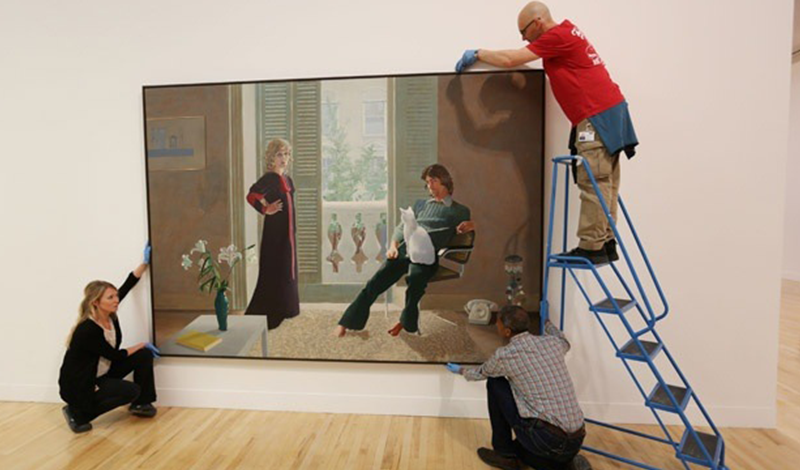
1. In what lighting does your artwork look best?
It is important to have the right lighting for your artwork to be set specifically for the artwork. Depending on what the artwork is and whether is has dark or light colours in it will effect the kind of light chosen. If unsure it is helpful to ask the gallery about what light they think will be most effective. Any light, especially sunlight has the ability to damage an artwork over a long period of time, so it is important to make sure that you use the best possible lighting. Different light options to consider include:
– Wall mounted spot lights, more common in brass and used in traditional homes or offices are a good way to illuminate smaller works as the wall mounted light does not have the distance from the wall to illuminate a large area. They are good at creating a mood around an artwork and inviting the viewer in to look closer at the work. Traditional brass wall mounted lights adds to the overall aesthetic and mood of the work
– Ceiling-mounted spotlights are one of the best ways to draw attention and illuminate a specific artwork, they allow for the light to be adjusted and the beam to illuminate the entire artwork. Place the light so it hits the center of the artwork at around a 30-degree angle. Going too close will create a shadow and going too far will result in a reflective glare on the work.
– A track lighting system comes in many different designs to suit many aesthetics and interiors. They work in a very similar way to the ceiling mounted light, they do however give you additional features once installed as they are easier to move and adjust. It is easier to add additional lights to the track if you want to light a large artwork if one light is not enough. However, you do have a track sitting on your ceiling and aesthetically it will take away from any other feature lights or chandeliers in the room.
– Many houses are fitted with ceiling mounted down lights that are mounted flush with the ceiling but have the ability to bere- directed at a specific place on the wall. They are a good alternative and less intrusive, however the light will not be as good as ceiling mounted track lighting.
– Wall washers are used to light the entire wall and the light is normally installed either on the wall, ceiling or floors it washes the entire wall in the same amount of light. It is not as specific as the other lighting but gives a very contemporary feeling and suits contemporary art. Wall washers are often used when lighting corporate collections.
– Use LED bulbs wherever possible as they do not give off any UV light or heat and will not damage the artwork. You can place UV filters on all halogen lamps but make sure to not put them too close to the artwork.
2. Consider how much an artwork weighs
The weight of an artwork will determine how the work is installed. Heavy works might need additional reinforcement to secure them to a wall. When heavy works are placed on a plinth it is important to reinforce the plinth to prevent it from toppling over, this can be done by screwing a footing into the floor the plinth sits over or by building a larger base on the foot of the plinth to balance the weight. Large outdoor sculptures also need to be secured for security and safety reasons.
3. Choosing the right form of hanging
It is preferred that any hooks attached to the frame should be done by the framer to avoid any damage to the artwork, if you have to add the hooks yourself it is important to measure the frame to avoid screwing the hook straight through the frame and damaging the artwork.
Some forms of hanging to consider include:
– D-Rings are available in a variety of sizes, which makes them suitable for a variety of frame sizes and also able to bear different weights. For framed artworks D-Rings are the preferred option, they should be screwed about ¼ of the way down from the top of the frame, make sure they are placed in exactly the same spot on the back of the frame, the artwork can then hang onto hooks or nails screwed into the wall. This might take longer than the wire and one screw option but it is much more secure and especially suitable for installing heavy artworks.
– Wire can also be placed between the two D-Rings and then only one screw or hook is placed on the wall, these works will not sit flush against the wall and will droop slightly forward. This method is not suitable for heavy works and is not as secure as two screws described above. Also think twice before using a wire for works on canvas as the nail sticking out of the wall can easily damage the canvas.
– Never use screw eyes because they can easily pull out of the artwork, they protrude and can scratch the frames or press into other frames when stacked in storage.
– When installing the work into the wall the best option is a tempered steel nail going into the wall at a downward angle. Tempered steel nails are thin and will leave minimal damage to the wall if the work needs to be moved. Do not re-use the nails, as they can be damaged and not as strong.
– There are a variety of hooks that can be attached into the wall and they are particularly suitable for heavy works as one hook can be attached with two screws and then the D-Ring will be hooked into the hook.
– French cleats are an overlapping design where you have a fixture with a 30-35 degree angle placed on the wall the artwork then hooks onto the cleat, this the ideal way to hang very large heavy work, or long artworks.
– Hanging Track is an art hanging system that offers an alternative system and consists of a track that can be either ceiling or wall mounted, there are several systems available with a variety of hook and cable options and it depends on the usage and look you are after.
4. Book an Installer for completed hangs
When booking an installer give them as much information as you can so they can come prepared. It’s important that they know the artwork’s dimensions and weight as well as the parameters of the space where it will be installed. If you bought the work from the gallery they will be able to recommend and brief an installer. You can also request the artist to install the work but not all artists have insurance or are technically trained to install artworks. It is however very nice to have the artist present when installing the work. Many collectors will have friends over and make a little event of the installation, celebrating it with the artist as a fantastic way to welcome the new piece into your home. Galleries are always happy to accompany an installer to help make sure the installation runs smoothly, especially for complicated artworks.
5. What about Sculptures?
Installing sculptures can be very complicated get clear instructions from the artist on how the work needs to be installed and supported to prevent the work being at risk of being damaged or hurting anyone. Outdoor sculptures should be secured to the ground or wall to prevent movement in heavy storms and possibility of public liability. It is important to check with the artist if the works are suitable to be outside, what temperature changes the material can handle, how to care for the work and if any damage occurs how to best repair the work.



